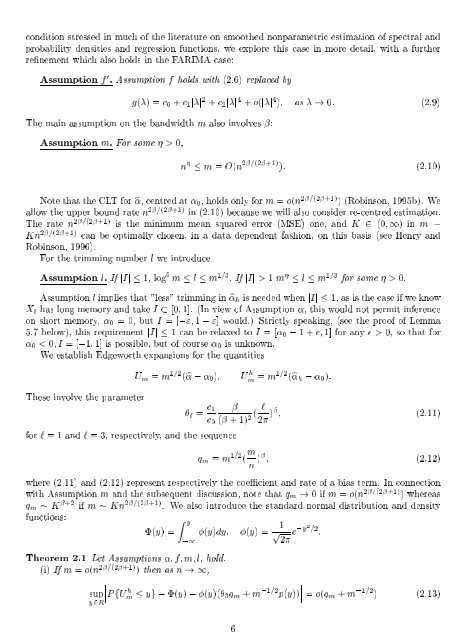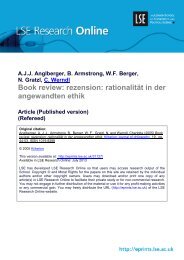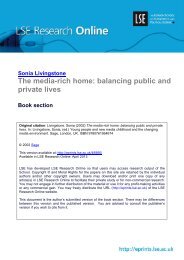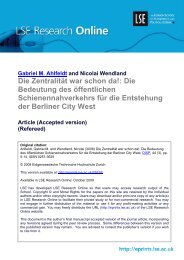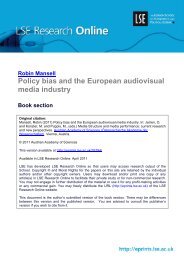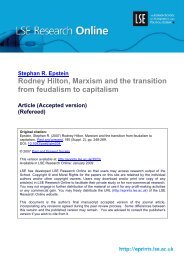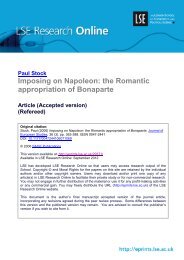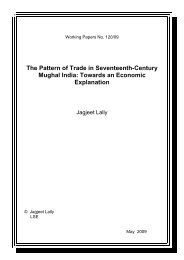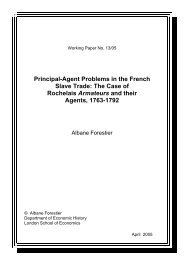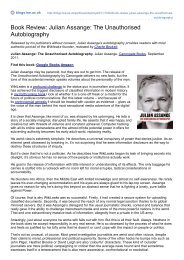Download (535Kb) - LSE Research Online - London School of ...
Download (535Kb) - LSE Research Online - London School of ...
Download (535Kb) - LSE Research Online - London School of ...
Create successful ePaper yourself
Turn your PDF publications into a flip-book with our unique Google optimized e-Paper software.
condition stressed in much <strong>of</strong> the literature on smoothed nonparametric estimation <strong>of</strong> spectral and<br />
probability densities and regression functions, we explore this case in more detail, with a further<br />
re nement which also holds in the FARIMA case:<br />
Assumption f 0 . Assumption f holds with (2.6) replaced by<br />
g( )=c0 + c1j j 2 + c2j j 4 + o(j j 4 ) as ! 0. (2.9)<br />
The main assumption on the bandwidth m also involves :<br />
Assumption m. For some >0,<br />
n m = O(n 2 =(2 +1) ): (2.10)<br />
Note that the CLT forb, centred at 0, holds only for m = o(n 2 =(2 +1) ) (Robinson, 1995b). We<br />
allow the upper bound rate n 2 =(2 +1) in (2.10) because we will also consider re-centred estimation.<br />
The rate n 2 =(2 +1) is the minimum mean squared error (MSE) one, and K 2 (0 1) in m<br />
Kn 2 =(2 +1) can be optimally chosen, in a data dependent fashion, on this basis (see Henry and<br />
Robinson, 1996).<br />
For the trimming number l we introduce<br />
Assumption l. If jIj 1, log 5 m l m 1=3 : If jIj > 1 m l m 1=3 for some >0.<br />
Assumption l implies that "less" trimming in bh is needed when jIj 1, as is the case if we know<br />
Xt has long memory and take I [0 1]. (In view <strong>of</strong> Assumption , this would not permit inference<br />
on short memory, 0 = 0, but I =[;" 1 ; "] would.) Strictly speaking, (see the pro<strong>of</strong> <strong>of</strong> Lemma<br />
5.7 below), this requirement jIj 1 can be relaxed to I =[ 0 ; 1+ 1] for any >0, so that for<br />
0 < 0I =[;1 1] is possible, but <strong>of</strong> course 0 is unknown.<br />
We establish Edgeworth expansions for the quantities<br />
These involve the parameter<br />
Um = m 1=2 (b ; 0) U h m = m 1=2 (bh ; 0):<br />
for ` = 1 and ` = 3, respectively, and the sequence<br />
` = c1 `<br />
( ) (2.11)<br />
c0 ( +1) 2 2<br />
qm = m 1=2 ( m<br />
) (2.12)<br />
n<br />
where (2.11) and (2.12) represent respectively the coe cient and rate <strong>of</strong> a bias term. In connection<br />
with Assumption m and the subsequent discussion, note that qm ! 0ifm = o(n 2 =(2 +1) ) whereas<br />
qm K +2 if m Kn 2 =(2 +1) . We also introduce the standard normal distribution and density<br />
functions:<br />
(y) =<br />
Z y<br />
;1<br />
Theorem 2.1 Let Assumptions f m l hold.<br />
(i) If m = o(n 2 =(2 +1) ) then as n !1,<br />
(y)dy (y) = 1<br />
p 2 e ;y2 =2 :<br />
sup P fU<br />
y2R<br />
h m yg; (y) ; (y)( 3qm + m ;1=2 p(y)) = o(qm + m ;1=2 ) (2.13)<br />
6


